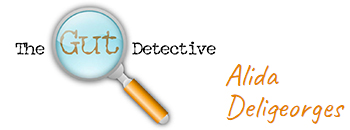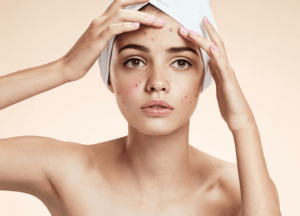
It’s easy to forget that your skin is a vital functioning organ. In fact, it is the largest organ in the body, with an average surface area of more than 2 square metres and accounting for around 15% of your body weight.
Your skin can say a lot about your health. Skin conditions like acne, rosacea, eczema, psoriasis, dermatitis, and allergic rashes are typically a symptom of something else going on in the body.
The skin is an ever-changing organ of the human body and is made up of many structures and cells. The skin maintains the proper temperature; depicts the right sensation, and helps in the immune system to protect the body from diseases.
What Is Really Going On?
The skin is our body’s largest elimination organ. The body often uses the skin to get rid of bad bacteria and toxins – especially when our gut and immune system are in poor health. The next time you’re dealing with skin eruptions, you’ll want to remember that true beauty starts from within.
Skin As A Messenger For Our Organs
Whenever we are faced with treating skin conditions, and, in particular, allergic skin disorders, it is prudent to remember the appearance and location of the presentation is the body’s way of letting us know what the real problem is and where it lies. Understanding the message the body is giving us and choosing the appropriate formula to correct the imbalance(s) driving the skin condition is the only way to achieve exceptional clinical results for patients with skin disorders.
Facial reading or mapping (known as physiognomy) is a common diagnostic tool within both Traditional Chinese Medicine (TCM) and Ayurvedic Medicine, with each internal organ and energy meridian connected to a specific area on the face. Since the skin is very thin and delicate on the face, the first signs of any health problems will be revealed in that specific area of the body. It can, therefore, be applied to learn about the overall state of a person’s health and to detect illnesses.
FACIAL MAPPING
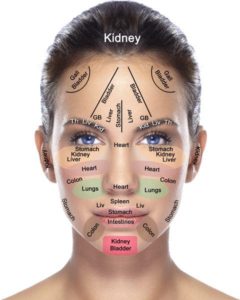
If something is affecting the skin, it might mean something internal is going on. Afflictions to look for include, pimples, rashes, creases/lines, or change of skin color/tone. Any of this could signify an internal issue that needs to be worked on for the skin and the body to be at optimal health.
Let’s take a closer look:
FOREHEAD: BLADDER, DIGESTIVE SYSTEM, AND SPLEEN
– Stress and ability to face challenges and deal with conflict
– Irregular sleep
– Sweat
– Toxin build-up from poor food choices and poor digestion
– Poor metabolism of fats/oils (gallbladder issues)
– Constipation or poor absorption of nutrients
– Spleen function and insulin resistance (the result of overindulging in comfort foods or carb overload)
BETWEEN EYEBROWS: LIVER AND STOMACH
– Dehydration
– The liver is stressed & overworked
– Excessive toxins/pollutants, alcohol, fatty foods, meat or dairy (may present as redness, flakiness, or excess oil)
– Possible allergies
EARS AND TEMPLES: KIDNEYS
– Dehydration (from smoking, alcohol, poor quality salt consumption and lack of water intake)
– Inflamed ears (hot and swollen)
– Stress
– Excess oil production
UNDER EYES: STOMACH, KIDNEY, AND LIVER
– Stress (e.g. adrenal fatigue)
– Lack of sleep (baggy, puffy skin)
– Dehydration (dark circles)
– Liver congestion
NOSE & UPPER CHEEK: HEART
– Blood pressure
– Poor circulation and congestion (seen as redness and broken capillaries)
– Salt intake
– Indoor & outdoor air pollution
LOWER CHEEKS: COLON AND LUNGS
– Allergies and asthma
– Poor air quality/pollution/smoking (presenting as spots, puffiness or broken capillaries)
– Digestive issues (poor food choices)
– High stress
UPPER LIP AREA: SPLEEN, LIVER, AND STOMACH
– Excessive fat/sweet food
– Excessive alcohol consumption
– Poor stomach health due to lack of digestive enzymes/acid
CHIN: INTESTINES, KIDNEY AND REPRODUCTIVE ORGANS
– Greasy foods and digestive issues
– Insufficient “good” fats to provide adequate cholesterol production (precursor to most hormones)
– Dehydration (excessive caffeine and insufficient water intake)
– Stress
– Being under artificial lights and lacking skin-to-skin connection with the Earth
– Hormones (fertility, menstrual issues, ovarian cysts)
– Eating hormone-injected meats and dairy products
JAWLINE: STOMACH AND REPRODUCTIVE ORGANS
– Greasy foods & insufficient healthy fats
– Hormones
– Eating hormone-injected meats and dairy products
– Poor hygiene/dirt (dirty pillowcases and cell phones)
NECK: ILLNESS
– Infection (weak immune system)
– Illnesses (e.g. Thyroid disease)
– Stress
What Is My Acne Telling Me?
The position in which pimples appear on the face can point to their cause. Identifying the cause of the problem will mean it can be treated appropriately.
So let’s examine this fact further.
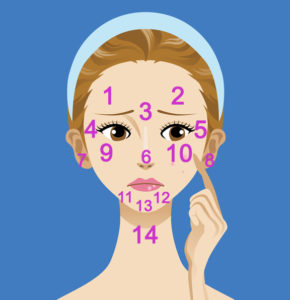
ZONES 1 & 2: Digestive System and Bladder
– Drink more water
– Improve diet by eating more raw foods (e.g. fruits and vegetables)
– Eat less processed or junk food
– Cut out sugar and reduce bad fats
– Work out if there is any possible food allergies or intolerances
– Remove alcohol
– Reduce stress (e.g. do some yoga)
– Get enough sleep
– Take some probiotics and digestive enzymes
ZONE 3: Liver and Stomach
– Eat less meat and dairy
– Remove alcohol, sugar and greasy processed food
– Eat more healthy foods including organic fruits and vegetables
– Remove any food allergies or intolerances
– Drink lemon and warm water each morning
– Get plenty of fresh air and light exercise daily
– Relax and slow down (try some meditation and yoga)
– Get adequate sleep so the liver can rest
ZONES 4 & 5: Kidneys
– Drink more water
– Remove drinks that dehydrate such as coffee, alcohol and fizzy soft drinks
– Replenish the adrenals with early nights
– Change table salt to sea salt
ZONE 6: Heart
– Keep blood pressure in check
– Maintain healthy cholesterol levels
– Make some lifestyle adjustments
– Get more fresh air and exercise to aid toxin removal
– Eat more “good” fats (e.g. avocados, nuts, fish, olives, and flaxseed)
– Eat less acidic foods
– Reduce levels of animal fats and protein
ZONES 7 & 8: Kidneys
– Drink up once again with extra water!
– Cut out soft drinks, coffee, and alcohol which further dehydrate
– Use only sea salt in the diet
ZONES 9 & 10: Lungs and Colon
– Quit smoking if you’re a smoker
– Avoid pollution
– Eliminate any allergies
– Avoid overheating by heating more cooling foods (e.g. salads, juices)
– Get more fresh air and exercise
– Reduce stress levels
– Eliminate acidic foods (e.g. meat, dairy, alcohol, caffeine, sugar) and add more alkalizing foods (e.g. green smoothies using cucumber, celery, lettuce, lemon/lime, and dark green leafy vegetables)
– Make healthier food choices and increase dietary fibre (e.g. eating more fruits and vegetables)
ZONES 11 & 12: Colon and Reproductive System
– Reduce stress
– Adjust any hormonal imbalances or overactivity (e.g. oestrogen excess from adrenal fatigue). Work with your practitioner to check your hormone levels
– Aim to get adequate sleep
– Drink plenty of water
– eat more leafy vegetables
ZONE 13: Intestines, Kidneys and Reproductive System
– Increase fibre intake (e.g. chia seeds or psyllium husks) and eat a balanced diet to improve digestion
– Reduce stress and toxin levels
– Drink plenty of water
– Drink herbal teas (e.g. nettle leaf tea for adrenals)
– Reduce “bad” fats and sweets
– Remove caffeine and alcohol consumption
ZONE 14: Illness
– Drink plenty of fluids
– Get lots of rest
– Eat well and perhaps a lesser amount, or even intermittent fasting
– Supplement with vitamins as needed (e.g. Vitamin C)
– Take a gentle yoga class to aid relaxation and to reconnect to the Earth (get “grounded”)
– Practice deep breathing
Healthy digestion = Good skin
When your digestion is off, or the toxins are not being eliminated properly, your skin jumps in, often showing signs in the form of a rash or skin problem.
Although it’s possible to have skin issues, such as acne, and not have gut issues, it is very rare.
The relationship between gut balance and clear skin can be traced back to 1930, when dermatologists John H. Stokes and Donald M. Pillsbury first proposed a gut-brain-skin unifying theory, connecting altered gastrointestinal tract function, emotional states (stress, depression, worry, and anxiety) and skin conditions such as acne.
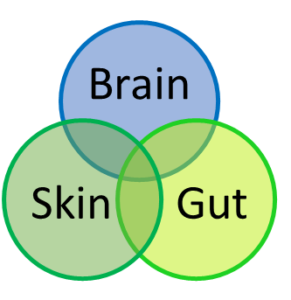
Even when there are no obvious digestive symptoms, it is vital to still work on supporting the gut, as there is always an improvement toward clearer skin.
**If you’ve got this far – thank you for reading and I look forward to bringing you more information in the future.
Now, enjoy some music to soothe your soul with some humour at the same time…
